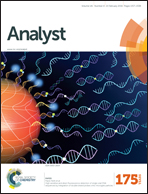Does size matter? Study of performance of pseudo-ELISAs based on molecularly imprinted polymer nanoparticles prepared for analytes of different sizes
Abstract
The aim of this work is to evaluate whether the size of the analyte used as template for the synthesis of molecularly imprinted polymer nanoparticles (nanoMIPs) can affect their performance in pseudo-enzyme linked immunosorbent assays (pseudo-ELISAs). Successful demonstration of a nanoMIPs-based pseudo-ELISA for vancomycin (1449.3 g mol−1) was demonstrated earlier. In the present investigation, the following analytes were selected: horseradish peroxidase (HRP, 44 kDa), cytochrome C (Cyt C, 12 kDa) biotin (244.31 g mol−1) and melamine (126.12 g mol−1). NanoMIPs with a similar composition for all analytes were synthesised by persulfate-initiated polymerisation in water. In addition, core–shell nanoMIPs coated with polyethylene glycol (PEG) and imprinted for melamine were produced in organics and tested. The polymerisation of the nanoparticles was done using a solid-phase approach with the correspondent template immobilised on glass beads. The performance of the nanoMIPs used as replacement for antibodies in direct pseudo-ELISA (for the enzymes) and competitive pseudo-ELISA for the smaller analytes was investigated. For the competitive mode we rely on competition for the binding to the nanoparticles between free analyte and corresponding analyte-HRP conjugate. The results revealed that the best performances were obtained for nanoMIPs synthesised in aqueous media for the larger analytes. In addition, this approach was successful for biotin but completely failed for the smallest template melamine. This problem was solved using nanoMIP prepared by UV polymerisation in an organic media with a PEG shell. This study demonstrates that the preparation of nanoMIP by solid-phase approach can produce material with high affinity and potential to replace antibodies in ELISA tests for both large and small analytes. This makes this technology versatile and applicable to practically any target analyte and diagnostic field.


 Please wait while we load your content...
Please wait while we load your content...